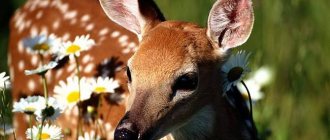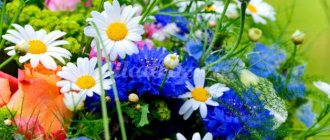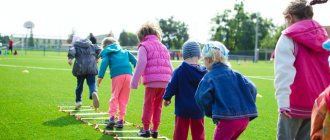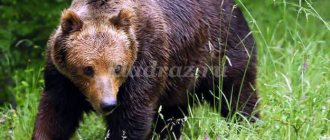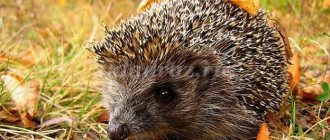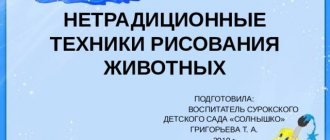Wild animals in winter or a trip to the winter forest. Games for children 1-2 years old.
The child learns about the world around him every day, and his parents help him with this. Today we decided to go with our baby to the winter forest and meet wild animals. Find out who lives in the forest, what they eat and what they do in winter. Our journey begins at the edge of the forest. A forest can be seen in the distance.
- Look how much snow is around, everything is white. What a beautiful snowball, it is fluffy and cold.
Here you can invite your child to touch snow if he is not yet familiar with it. Put it in a cup and watch what happens to it over time.
- Well, we need to move on. Look at the snowdrifts. Let's call the wind to help, let it blow our way.
Breathing exercise “Snowflakes are flying”
Take a tray with small pieces of paper or cotton wool. Invite your child to blow on it - “snowflakes” scatter around the room like snow.
- So the path to the forest animals is clear. Only on the way did we see a river. What to do? How to get into the forest? Yes, here is a narrow bridge, we boldly walk along it (you can put a scarf, blanket or sheets of paper). Let's move on. But there are many obstacles in the forest. To get to know wild animals, you need to overcome them.
Here, disorder will help you in the game: scattered cubes (it is better to use soft ones), boxes, laces and other toys.
In the forest you need to step or climb over fallen trees (twisted blanket or carpet), step over branches (laces, ropes, jump rope), climb over bushes (cubes, boxes).
This can be done both before meeting all the animals, and after meeting one of them.
Who lives in the forest? Let me help you. Take these cards, let's look at them together. These are wild animals. Let's call them: bear, hare, fox, wolf, squirrel. Let's go meet them.
Here we are walking through the forest
And the wolf - Oooh.
Let's call him together - Oooh (develops the mobility of the articulatory apparatus). We take a toy wolf - he came running to us. Invite your child to say hello to the wolf. Click your teeth like a wolf (gray wolf clicks his teeth). We say that a wolf's teeth are large and strong. The bunny is afraid of him.
Here we are walking through the forest
And the fox - A-a-a (she sings a song like that).
What kind of face? Beautiful, red-haired, she has a fluffy, long tail. What other colors do we have? Carrot, orange. Walk with your child on his toes.
Here we are walking through the forest
And the bear - O-o-o.
The bear came running to us. Show your child how a bear waddles. Walk with your baby like a bear. What does a bear do in winter? He sleeps in his den. Our bear also wants to sleep, but he doesn’t have a den.
Build a den with your little one using a construction set.
A bunny came running to us - we imitate his movements (jump).
We play the game “The little gray bunny sits and moves his ears” - we show all the movements.
The bunny has long ears and a short tail. Tell your child that in the summer the bunny is gray and in the winter it turns white so that it is not noticeable in the snow. This is how he disguises himself from the wolf. Print out two bunny coloring pages. Color one of them gray. Guess where the winter bunny is and where the summer one is. You can draw grass in an album and plant a summer bunny on it, and a winter bunny on the snow.
Game "Wolf and Hares"
Invite your child to be a bunny and run away from the mother wolf. Then switch places. The squirrel also came to us. She worked all summer and collected a lot of nuts. Where our squirrel lives - in a hollow in a tree.
Game for developing fine motor skills “Find the nuts”
Pour semolina or other cereal into a container and hide the nuts in it. Invite your child to find nuts for the squirrel and feed it.
Educational game “Show body parts”
Take the toys and ask the child to show where their paws, ears, tail, etc. are. It will be more interesting for the child if the mother begins to imitate the voices of animals. For example, speak in a low voice and pretend to be a bear. “Oh, I forgot something, where is my ponytail. Help me please".
Game with sticks "Long and short"
Our animals froze in the forest in winter. Let's help them light a fire so they can warm themselves up. We need twigs.
Take counting sticks of different sizes - long and short. Mix them and ask your child to arrange them into two piles, depending on their length.
Playing with plasticine “Bonfire”
Roll out the sausages with your child - these will be twigs for the fire. Now make the fire itself and attach it to the “twigs”. Place the animals around the “plasticine flame” to warm themselves.
Lesson summary "Wild Animals"
Theme of integrated educational activities: “Wild animals”. Age group
: older.
Motivations for children's activities: -problem situation -
an evil sorceress bewitched the animals, organizing a solution to the problem through children's play activities.
Methods for activating children's activities in the process of OD:
Visual, verbal, practical and playful.
Techniques for activating children’s activities in the process of OD:
Conversation, didactic games: “Who eats what”, “Who lives where?”, “Who has whom”, “Tell about animals”, “Make a wild animal”, use of TSO.
Techniques for maintaining interest in children:
Problem situation, didactic games and exercises, encouragement, physical activity, surprise moment.
Methods of assessment and self-assessment:
incentives, self-checking of practical activities, mutual checking.
Integration of educational areas:
“Speech development”, “Cognitive development”, “Social and communicative”, “Artistic and aesthetic development”, “Physical development”.
Types of children's activities:
gaming, communicative, motor, visual, musical.
Planned results: Personal:
reacts emotionally to play situations created by the teacher, desires cooperation with the teacher and other children, knows how to act independently, and, if necessary, seek help from an adult or peer, inquisitive, communicative.
Intellectual
: knows and names wild animals, names baby animals, their homes, knows how to answer questions, understands the teacher’s instructions, attentive, resourceful.
Physically:
mobile, active.
Equipment:
interactive board, box, object pictures, didactic games, cut-out picture of a forest, molded samples of wild animals, plasticine, napkins, oilcloths, stacks.
Preliminary work:
Conversation “Wild Animals”, solving riddles, looking at pictures, playing didactic games “Cut-out pictures”, “Who lives where”, “Who eats what”, learning physical exercises, poetry, watching a film about wild animals, writing a story about a wild animal with its parents.
Goal :
Expand children's understanding of wild animals, their way of life, habits, nutrition and homes.
Objectives : Educational:
-teach children to guess riddles by description;
- consolidate children’s knowledge about the peculiarities of the lifestyle of wild animals; - practice naming wild animals and their young; -expand your vocabulary using nouns and adjectives; -continue to teach children to answer the teacher’s questions in complete sentences; - to strengthen in children the ability to sculpt animals according to a model, according to a diagram, according to an idea; - consolidate the ability to sculpt an animal figurine in parts, using different techniques: rolling plasticine between the palms, pulling small parts, connecting parts by pressing and smoothing the joints. Correctional and developmental :
- develop coherent speech;
-develop visual perception, logical thinking; -develop motor activity of children; -develop children's cognitive interest; -develop fine motor skills of the hand; - implement a differentiated approach to the child. Educational :
- to develop the ability to listen carefully and follow the teacher’s instructions, the ability to work in a group, negotiate, and take into account the opinions of other children;
- to cultivate curiosity, love and respect for wild animals; — to cultivate interest in working with plasticine, to evoke positive emotions from the work process and its result; -continue to teach how to evaluate the results of your work and the work of a friend. Vocabulary :
wild animals (hare, fox, wolf, bear, hedgehog, squirrel).
Habits. Hollow, den, lair, hole. Clumsy, prickly, confuse tracks, look for food. Herbivores, omnivores, carnivores. Time 30 minutes.
Educational activity plan:
I. Organizational moment. 1.Surprise moment. II. Main part. 1. Game “Guess the riddle.” 2. Game “Feed the animals”. 3. Game "Who has who." 4. Game “Who Lives Where”. 5. Game “Tell about the animal.” 6. Modeling animals. III. Final part.
Progress of educational activities.
Organizing time. Educator:
“Dear guests, we are glad that you came to us and invite you to stand in a circle with us and play a little.”
-Let’s stand side by side, in a circle, (children with teachers stand in a circle) -Say “Hello!” to each other (turn to face each other) - We are not too lazy to say hello, (put palm to palm) - “Hello” to everyone! and “Good afternoon!” (share hands with each other) -If everyone smiles- (hold hands) -Good morning will begin. -
Good morning!
Teacher:
“Thank you, have a seat.” Children sit on chairs.
There's a knock on the door. The teacher brings in the box. Educator:
“Guys, Lesovichok sent us a box.
Let's see what's there. Oh, there's some kind of disk here. What's on the disk? Maybe cartoons? Let's get a look. Lesovichok
: “Dear guys, trouble happened in our fairy-tale forest, an evil witch drove the animals out of the forest.
They were left without their home, lost their cubs and were very hungry. To help the animals, you need to complete tasks that the evil witch came up with. She cut a painting of animals into several pieces. You must assemble the picture from parts and complete the witch's tasks to return the animals to the forest. Tasks with cut pictures are in the box. Educator:
“Guys, let’s help Lesovich?”
And here is the task. What is the number on the envelope? Task No. 1.
Guess the riddles. Not a lamb or a cat, wears a fur coat all year round.
Gray fur coat for summer For winter, a different color ((a picture of a hare appears on the screen). A picture of a hare appears on the screen).
A cunning cheat, A lush tail sticking out from the top, A red head What kind of strange little animal is this? A fluffy tail is a beauty. He cracks nuts finely. Who is this (fox).
Well, of course it’s (
a squirrel).
In a dense forest under a fir tree, the owner of the forest wakes up in the spring, showered with leaves, and in winter, under a blizzard howl, lies a bag of needles, sleeping in a snow hut (a bear).
Prickly and alive (hedgehog).
Who walks around in the cold winter, angry and hungry (wolf).
-Guys, who do you think these riddles were about?
(about animals).
- Where do all these animals live (in the forest, in nature).
-Who feeds them? (they find food for themselves, get it). -What can you call animals that live in the forest and get their own food? (wild animals).
-if we guessed the riddles correctly, we will be able to find part of the picture in the box.
and here is the picture, we will now place it on the board. The evil witch has come up with another task for us. To complete the next task, go to the tables. One child places part of the picture on the board. Task No. 2. Didactic game “Feed the animals.” (work on magnetic boards). Educator:
“Guys, in front of you are magnetic boards and envelopes containing pictures of animals and pictures depicting what animals eat.
Select the pictures you need." Children check with each other whether the work has been completed correctly. Tell us what animals eat. -What can you call animals that eat plant foods (herbivores).
-What can you call animals that feed on other animals
(predators).
— What can you call animals that eat plant foods and other animals
(omnivores). Educator
: “Come on, we will distribute your animals according to these species.
Well done guys, we completed this task. We place the second part of the cut picture. And in the next task the sorceress offers to play. Task No. 3.
Didactic game "Who has whom." The teacher throws a ball to each child and calls: “The fox has...”, the child answers - a fox, a hare has a bunny, a squirrel has a squirrel, a hedgehog has a hedgehog, a bear has a bear cub, a wolf has a wolf cub.”
Mothers have found their babies, we place the 3rd part of the cut picture. Well done, sit down on the chairs. Children sit in front of the sensory board. Educator: “
The evil witch came up with task 4 for us.
Task No. 4. “Didactic game “Who lives where?”
-Where does the squirrel live?
(in the hollow) (slide 1). -Where does the bear live? (in the den). (slide 2). -Where does the wolf live? (in the lair). (slide 3). -Where does the hedgehog live? ( in the hole). - Where does the fox live (in the hole). -Where does the hare live? (under a bush). Children answer in complete sentences (the squirrel lives in a hollow). Educator:
“The task has been completed, we place the fourth part of the cut picture.”
Task No. 5.
"Tell me about animals." —
Educator:
“Next task.
Guys, to help wild animals, we must write a story about animals. Who wants to tell? During this story, another part of the picture should appear. If anyone finds it difficult, they can tell you according to the diagram. And who can tell for themselves? Children talk about animals." The teacher invites the child to put the 5th part of the cut picture. Educator:
“The witch was angry that we were coping with all the tasks and decided to send us the last difficult task.
Do you think we can handle it?” The teacher reads task 6: “If you can sculpt animals, then so be it, I will return them to the forest, but first let’s rest. Physical exercise.
Like our animals.
The paws are merrily knocking: Top-top, top-top, top-top (stomp) And the legs are tired, They clap their palms: Clap - clap, clap-clap, clap-clap (claps) And then squat, (squat). The animals are dancing side by side (jumping). And how they start running (running in place). No one can catch them. Task No. 6 “Blind any wild animal.”
Educator: “Guys, think about what kind of animal you will sculpt?
Who can make their own? Some may use a model, others may benefit from a diagram. Children independently take plasticine and the necessary attributes. Music plays while sculpting. While working, I watch children. Sometimes I provide a little help. At the end of sculpting we look at the animals. I ask some children who they made. Let's make the animals happy. Let’s tell poems about them.” Educator
: “We completed the task.
We place the last part of the cut picture. What did we get? Picture of a forest with animals. Educator
: “Who asked us for help? Who did we help today? List. What tasks did we complete? (they found the cubs, told where wild animals live and what they eat). Children, look, all the animals have returned to the forest. They are joyful, they say thank you, and the evil witch has disappeared and will no longer appear in the forest.”
6
